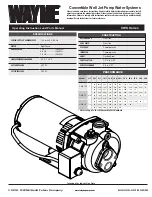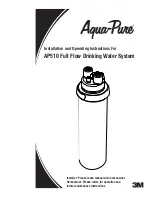
13
10. BACKFILLING AROUND COLLECTION TANK
Careful selection, placement and compaction of approved backfill
materials is critical to the successful collection tank installation.
Common causes of leaks or collection tank failures include:
• Use of incorrect backfill material
• Improper placement of backfill material
• Inadequate compaction of backfill material
• Rocks, clods, frozen matter or other debris in the backfill material
• Voids under or around the collection tank
• Failure to prevent the migration of the backfill
10.1 Approved Backfill Materials
The following materials are approved as
backfill materials when installed as detailed
below. All backfill materials must be free of
rocks, clods, roots, organic material, frozen
matter and any other debris.
NOTICE
Use of alternative
materials or methods is strictly prohibited
and will immediately void the warranty without
prior written authorization from Franklin Electric
Angular Aggregate, Open Graded, Class 1A
Class 1A materials as defined in ASTM D 2321 provide maximum
stability and support for a given density due to the angular interlock
of particles. With minimum effort, Class 1A materials can be installed
to relatively high densities over a wide range of moisture contents.
Their high permeability may aid in the control of water. However,
avoid placing above, below or adjacent to finer materials when
ground water flow is suspected, unless methods are used to prevent
migration, which will undermine the support of the collection tank.
Aggregate, Dense Graded, Class 1B
Class 1B materials as defined by ASTM D 2321 are created by combining
Class 1A and natural or processed sands to produce a particle distribution
that minimizes migration from adjacent materials that contains fines.
Because they are densely-graded, they will require more compaction
effort than Class 1A to achieve the same density. Class 1B materials offer
high stiffness and strength when properly compacted and, depending
on the percentage of fines, may be relatively free draining.
Gravels, Sands and Soils, Class 2
Class 2 materials as defined by ASTM D 2321, include clean gravels and
sands with less than 5% fines and clean, compactible soil that contain
less than 12% fines. Class 2 materials consist of rounded materials and
are less stable than Class 1 angular materials. They will not provide
adequate support unless they are carefully compacted and confined
with a geotextile fabric liner.
10.2 Flowable Fills
Flowable fills, such as low lump concrete, are recommended when
installing the PowerSewer® in augered holes which do not provide
sufficient clearance to place and compact the other approved dry fills.
It is important to carefully place the flowable fills to ensure that the
constituent materials do not separate.
NOTICE
Heavy non-compactible clays and silts are
unacceptable backfill for this or any other underground structure
such as inlet or discharge pipe Contact Franklin Electric Technical
Services before using alternative backfill materials Failure to
follow these backfilling instructions or material requirements will
immediately void the warranty
10.3 Placement and Compaction
Place backfill materials in lifts no deeper than 12" and compact to a
minimum density of 85% Standard Proctor.
CAUTION
Do not permit the compaction equipment
to contact and damage the collection tank, piping or electrical cables
NOTICE
The various approved backfill materials will
require different levels of compaction and confinement effort to
achieve the proper density and ensure long-term underground
performance If uncertain, refer to ASTM D 2321 or contact Franklin
Electric Technical Services at 866-271-2859 before proceeding
NOTICE
To keep dry well and cover fasteners clear of
moisture and debris, keep cover bolted in place while backfilling
NOTICE
Before using heavy equipment near or directly
over the PowerSewer® system, pipe or electrical cables, place
sufficient backfill that has been compacted to prevent damage,
excessive deflection or other damaging disturbance
10.4 Finished Grade
The finished grade should be 1-1/2" to 2" below the rim of the
collection tank. It should always slope away from the dry well to
prevent ground or surface water from pooling on or collecting in the
collection tank dry well.
Summary of Contents for PowerSewer V4PS
Page 1: ...V4PS Installation Operation Maintenance Manual...
Page 31: ...31 NOTES...














































